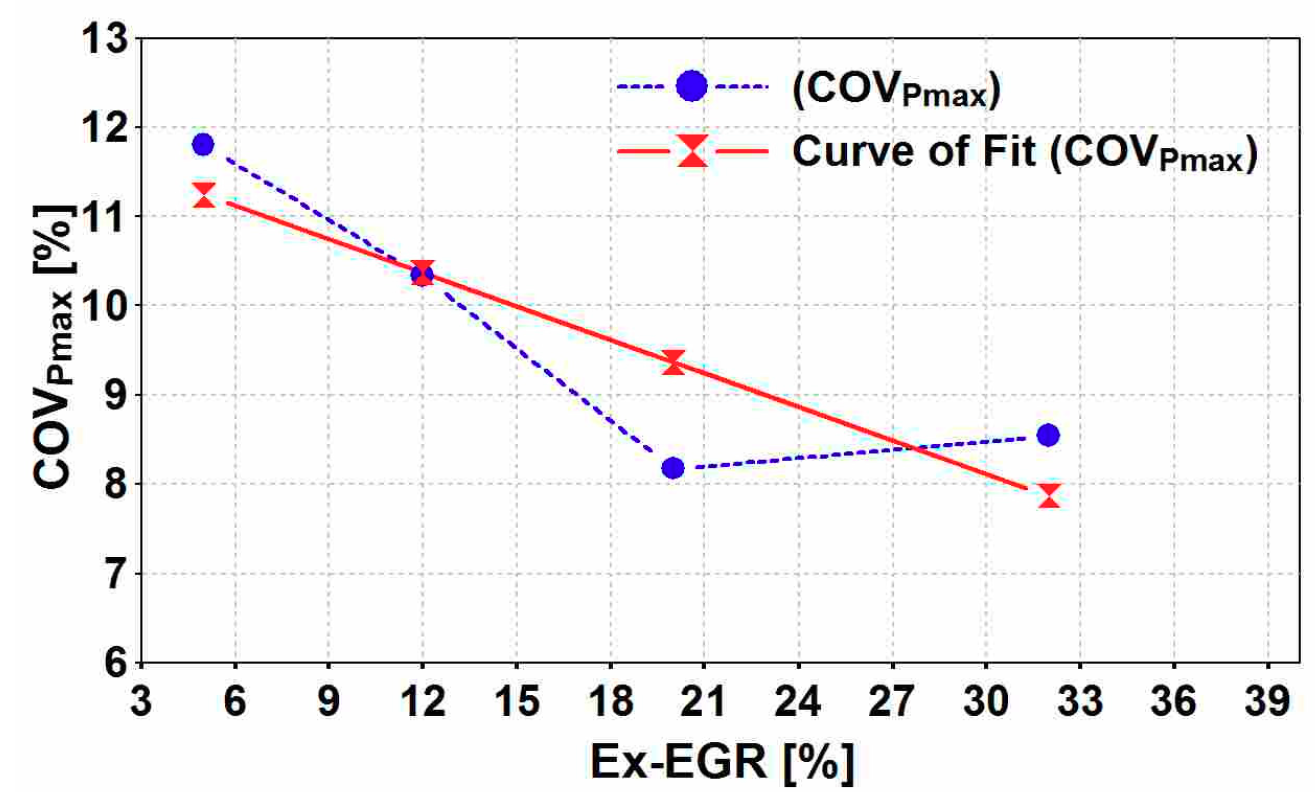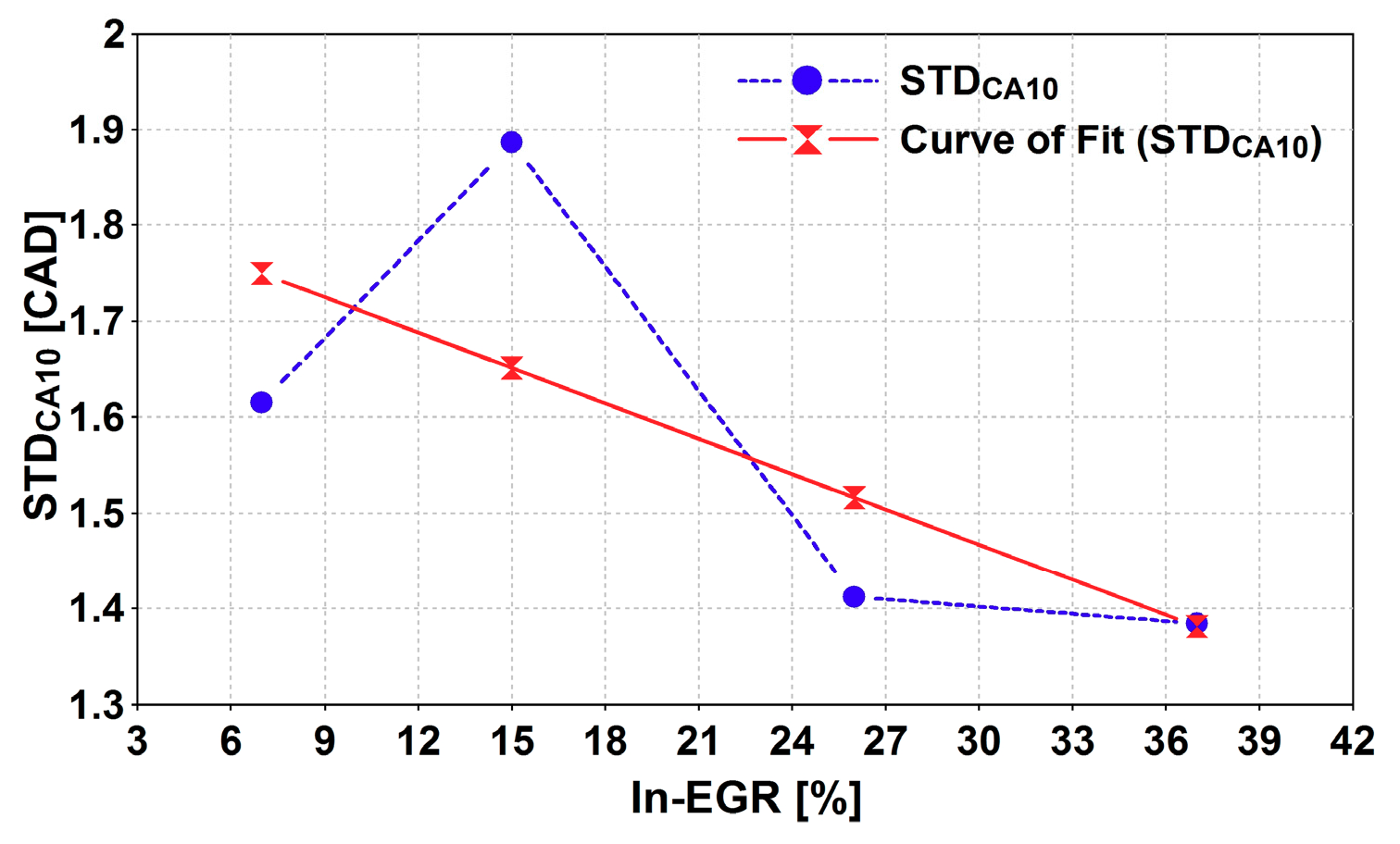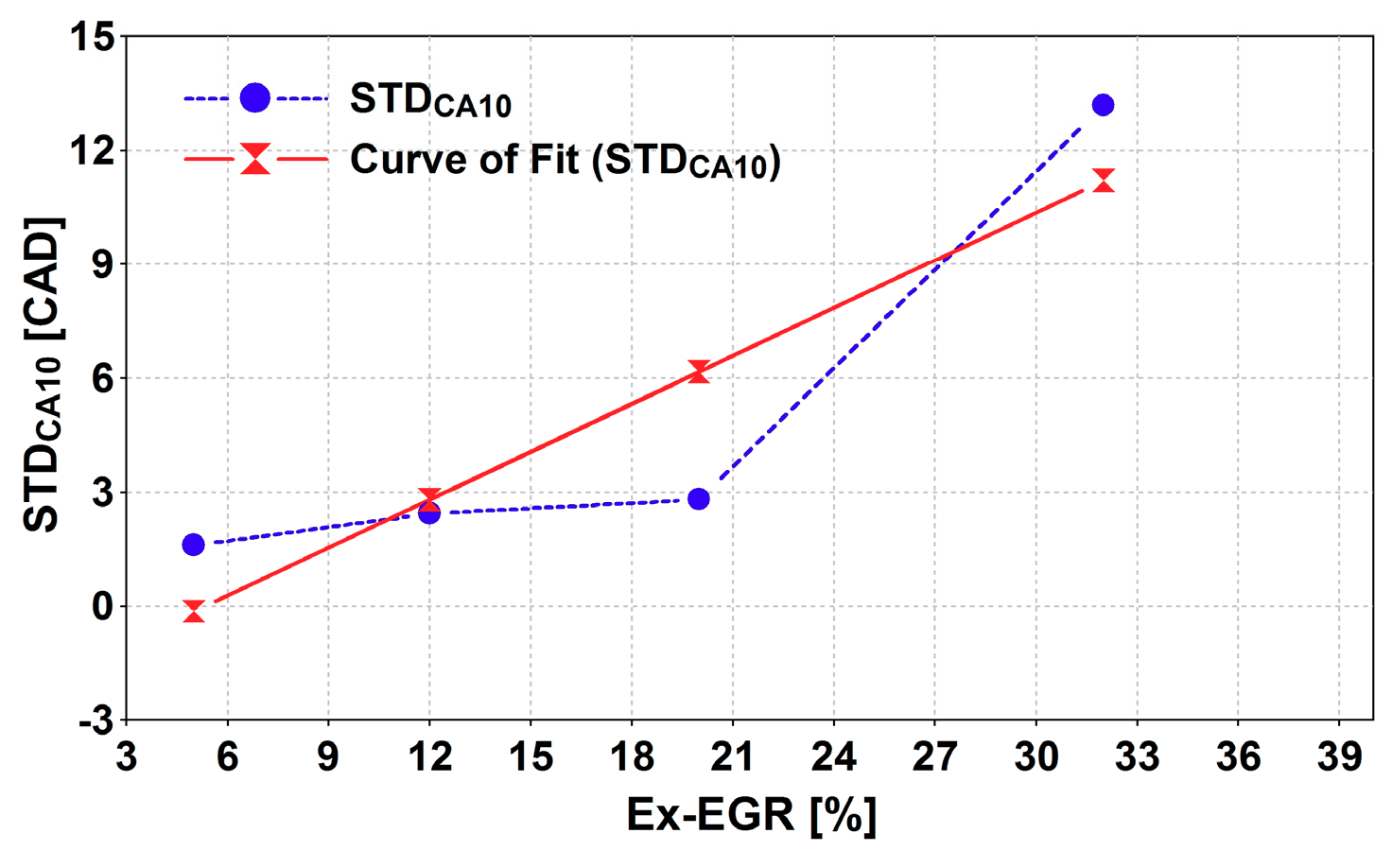Combustion and Emission Enhancement of a Spark Ignition Two-Stroke Cycle Engine Utilizing Internal and External Exhaust Gas Recirculation Approach at Low-Load Operation
Abstract
:1. Introduction
2. Influence of EGR Application
3. Engine Specifications
4. Instrumentation and Test Procedure
5. In-Cylinder Gas Thermodynamic and Scavenging Model
6. Estimation of In-EGR and Ex-EGR Rate
7. Results and Discussions
7.1. Idling, Low-Load and Mid-Load Misfiring Improvement
7.2. Combustion Stability and Cyclic Variability Improvement
7.3. Idling, Low-Load and Mid-Load Emissions Improvement
8. Conclusion
- The overall effect of EGR is to increase the cylinder charge temperature, which has proven to produce higher exhaust port closure temperature (Tepc) resulting in lower misfiring cycles.
- Reduction in the misfire occurrence due to EGR is apparent at the engine’s lower engine speed region.
- As for average charge temperature (Tepc), In-EGR is more effective than Ex-EGR. It not only increases the Tepc but also increase the pressure of cylinder at the start of combustion (Pepc).
- Both In-EGR and Ex-EGR improve the cyclic variability of the combustion parameters, specifically the IMEP.
- The cyclic variability of CA10, IMEP and Pmax will be further improved by applying In-EGR. Ex-EGR will impair cyclic variability of CA10, IMEP but will improve Pmax.
- The application of EGR offers a significant means to improve and eliminate low and mid load misfire combustion of spark ignition two-stroke cycle engine leading to emission reduction.
Author Contributions
Acknowledgments
Conflicts of Interest
Glossary
| a/bTDC | after/before top dead center |
| AFR | engine air-to-fuel ratio center |
| CO2 | carbon dioxide |
| COV | coefficient of variation |
| CA10 | crank angle at 10% of mass fraction burned |
| Ex-EGR | external exhaust gas recirculation |
| HCCI | homogeneous charge compression ignition |
| IMEP | indicated mean effective pressure |
| In-EGR | internal exhaust gas recirculation |
| K0, K1, K2 | scavenging coefficients |
| k | heat capacity ratio |
| Lap | applied corrected delivery ratio |
| Linh | inherent corrected delivery ratio |
| m•fuel | fuel mass flow rate |
| Mdel | mass of fresh charge delivered |
| Mtr | mass of total gas trapped |
| NOX | nitric oxides |
| Ns | engine speed in RPM |
| NTC | negative temperature coefficient |
| Pepc | in-cylinder pressure at exhaust port closure |
| Pmax | maximum in-cylinder pressure |
| STD | standard deviation |
| R | specific gas constant |
| Tex | exhaust gas temperature |
| Tepc | in-cylinder gas temperature at exhaust port closure |
| Tepo | in-cylinder gas temperature at exhaust port opening |
| Tsc | scavenging gas temperature |
| Tr | residual gas temperature |
| uHC | unburned hydrocarbon |
| Vepc | sweep volume at exhaust port closure |
| γinh | inherent residual gas ratio |
| γap | applied residual gas ratio |
| inherent scavenging efficiency | |
| applied scavenging efficiency |
References
- Benajes, J.; Novella, R.; De Lima, D.; Tribotté, P.; Quechon, N.; Obernesser, P.; Dugue, V. Analysis of the combustion process, pollutant emissions and efficiency of an innovative 2-stroke HSDI engine designed for automotive applications. Appl. Therm. Eng. 2013, 58, 181–193. [Google Scholar] [CrossRef] [Green Version]
- Duret, P. A New Generation of Engine Combustion Processes for the Future?: Proceedings of the International Congress, Held in Rueil-Malmaison, France, November, 26–27, 2001; Editions Technip: Rueil-Malmaison, France, 2002. [Google Scholar]
- Mahmoudzadeh Andwari, A.; Abdul Aziz, A.; Muhamad Said, M.F.; Abdul Latiff, Z. An experimental study on the influence of EGR rate and fuel octane number on the combustion characteristics of a CAI two-stroke cycle engine. Appl. Therm. Eng. 2014, 71, 248–258. [Google Scholar] [CrossRef]
- Ishibashi, Y. Basic Understanding of Activated Radical Combustion and Its Two-Stroke Engine Application and Benefits; SAE Paper 2000-01-1836; SAE International: Warrendale, PA, USA, 2000. [Google Scholar]
- Mahmoudzadeh Andwari, A.; Aziz, A.A.; Said, M.F.M.; Esfahanian, V.; Latiff, Z.A.; Said, S.N.M. Effect of internal and external EGR on cyclic variability and emissions of a spark ignition two-stroke cycle gasoline engine. J. Mech. Eng. Sci. 2017, 11, 3004–3014. [Google Scholar] [CrossRef]
- Mahmoudzadeh Andwari, A.; Aziz, A.A.; Said, M.F.M.; Latiff, Z.A. Experimental investigation of the influence of internal and external EGR on the combustion characteristics of a controlled auto-ignition two-stroke cycle engine. Appl. Energy 2014, 134, 1–10. [Google Scholar] [CrossRef]
- Zhao, H. HCCI and CAI Engines for the Automotive Industry; Woodhead Pub: Cambridge, UK, 2007. [Google Scholar]
- Zhao, H.; Ladommatos, N. Engine Combustion Instrumentation and Diagnostics; Society of Automotive Engineers: Warrendale, PA, USA, 2001; Volume 842. [Google Scholar]
- Asai, M.; Kurosaki, T.; Okada, K. Analysis on Fuel Economy Improvement and Exhaust Emission Reduction in a Two-Stroke Engine by Using an Exhaust Valve; SAE Paper 951764; SAE International: Warrendale, PA, USA, 1995. [Google Scholar]
- Blair, G.P.; Kenny, R.G. Further Developments in Scavenging Analysis for Two-Cycle Engines; SAE International: Warrendale, PA, USA, 1980. [Google Scholar]
- Fang, Q.; Fang, J.; Zhuang, J.; Huang, Z. Influences of pilot injection and exhaust gas recirculation (EGR) on combustion and emissions in a HCCI-DI combustion engine. Appl. Therm. Eng. 2012, 48, 97–104. [Google Scholar] [CrossRef]
- Mahmoudzadeh Andwari, A.; Azhar, A.A. Homogenous Charge Compression Ignition (HCCI) Technique: A Review for Application in Two-Stroke Gasoline Engines. Appl. Mech. Mater. 2012, 165, 53–57. [Google Scholar]
- Mahmoudzadeh Andwari, A.; Aziz, A.A.; Muhamad Said, M.F.; Abdul Latiff, Z. Controlled Auto-Ignition Combustion in a Two-Stroke Cycle Engine Using Hot Burned Gases. Appl. Mech. Mater. 2013, 388, 201–205. [Google Scholar] [CrossRef]
- Mahmoudzadeh Andwari, A.; Pesiridis, A.; Esfahanian, V.; Salavati-Zadeh, A.; Karvountzis-Kontakiotis, A.; Muralidharan, V. A Comparative Study of the Effect of Turbocompounding and ORC Waste Heat Recovery Systems on the Performance of a Turbocharged Heavy-Duty Diesel Engine. Energies 2017, 10, 1087. [Google Scholar] [CrossRef]
- Blair, G.P. The Basic Design of Two-Stroke Engines; Society of Automotive Engineers: SAE International: Warrendale, PA, USA, 1990. [Google Scholar]
- Duret, P. A New Generation of Two-Stroke Engines for the Future?: Proceedings of the International Seminar Held in Rueil-Malmaison, France, November 29-30, 1993; Éditions Technip: Rueil-Malmaison, France, 1993. [Google Scholar]
- Duret, P.; Moreau, J.-F. Reduction of Pollutant Emissions of the IAPAC Two-Stroke Engine with Compressed Air Assisted Fuel Injection; SAE Paper 900801; SAE International: Warrendale, PA, USA, 1990. [Google Scholar]
- Ishibashi, Y.; Asai, M. Improving the Exhaust Emissions of Two-Stroke Engines by Applying the Activated Radical Combustion; SAE Paper 960742; SAE International: Warrendale, PA, USA, 1996. [Google Scholar]
- Mahmoudzadeh Andwari, A.; Aziz, A.A.; Said, M.F.M.; Latiff, Z.A. A Converted Two-Stroke Cycle Engine for Compression Ignition Combustion. Appl. Mech. Mater. 2014, 663, 331–335. [Google Scholar] [CrossRef]
- Mahmoudzadeh Andwari, A.; Aziz, A.A.; Said, M.F.M.; Latiff, Z.A.; Ghanaati, A. Influence Of Hot Burned Gas Utilization On The Exhaust Emission Characteristics Of A Controlled Auto-Ignition Two-Stroke Cycle Engine. Int. J. Automot. Mech. Eng. 2015, 11, 2229–8649. [Google Scholar]
- Mahmoudzadeh Andwari, A.; Pesiridis, A.; Karvountzis-Kontakiotis, A.; Esfahanian, V. Hybrid electric vehicle performance with organic rankine cycle waste heat recovery system. Appl. Sci. 2017, 7, 437. [Google Scholar] [CrossRef]
- Nishi, M.; Kanehara, M.; Iida, N. Assessment for innovative combustion on HCCI engine by controlling EGR ratio and engine speed. Appl. Therm. Eng. 2016, 99, 42–60. [Google Scholar] [CrossRef]
- Nishida, K.; Sakuyama, H.; Kimijima, T. Improvement of Fuel Economy Using a New Concept of Two-Stroke Gasoline Engine Applying Stratified-Charge Auto-Ignition; The Automotive Research Association of India: India, 2009. [Google Scholar]
- Noguchi, M.; Tanaka, Y.; Tanaka, T.; Takeuchi, Y. A Study on Gasoline Engine Combustion by Observation of Intermediate Reactive Products during Combustion; SAE Paper 790840; SAE International: Warrendale, PA, USA, 1979. [Google Scholar]
- Onishi, S.; Jo, S.H.; Shoda, K.; Jo, P.D.; Kato, S. Active Thermo-Atmosphere Combustion (ATAC)—A New Combustion Process for Internal Combustion Engines; SAE Paper 790501; SAE International: Warrendale, PA, USA, 1979. [Google Scholar]
- Ozdor, N.; Dulger, M.; Sher, E. Cyclic Variability in Spark Ignition Engines A Literature Survey; SAE International: Warrendale, PA, USA, 1994. [Google Scholar]
- Salvi, B.L.; Subramanian, K.A. Experimental investigation on effects of exhaust gas recirculation on flame kernel growth rate in a hydrogen fuelled spark ignition engine. Appl. Therm. Eng. 2016, 107, 48–54. [Google Scholar] [CrossRef]
- Takei, T.; Iida, N. Study on Auto-Ignition and Combustion Completion of n-Butane in a Two-stroke Homogeneous Charge Compression Ignition (HCCI) Engine; SAE Paper 2002-32-1786; SAE International: Warrendale, PA, USA, 2002. [Google Scholar]
- Yao, M.; Zheng, Z.; Liu, H. Progress and recent trends in homogeneous charge compression ignition (HCCI) engines. Prog. Energy Combust. Sci. 2009, 35, 398–437. [Google Scholar] [CrossRef]
- Zhang, Y.; Zhao, H.; Ojapah, M.; Cairns, A. CAI combustion of gasoline and its mixture with ethanol in a 2-stroke poppet valve DI gasoline engine. Fuel 2013, 109, 661–668. [Google Scholar] [CrossRef] [Green Version]
- Yu, X.; Wu, H.; Du, Y.; Tang, Y.; Liu, L.; Niu, R. Research on cycle-by-cycle variations of an SI engine with hydrogen direct injection under lean burn conditions. Appl. Therm. Eng. 2016, 109, 569–581. [Google Scholar] [CrossRef]
- Mahmoudzadeh Andwari, A.; Said, M.F.M.; Aziz, A.A.; Esfahanian, V.; Salavati-Zadeh, A.; Idris, M.A.; Perang, M.R.M.; Jamil, H.M. Design, Modeling and Simulation of a High-Pressure Gasoline Direct Injection (GDI) Pump for Small Engine Applications. J. Mech. Eng. 2018, 1, 107–120. [Google Scholar]
- Mahmoudzadeh Andwari, A.; Said, M.F.M.; Aziz, A.A.; Esfahanian, V.; Baker, M.R.A.; Perang, M.R.M.; Jamil, H.M. A Study on Gasoline Direct Injection (GDI) Pump System Performance using Model-Based Simulation. J. Soc. Automot. Eng. Malays. 2018, 2, 14–22. [Google Scholar]
- Iida, N.; Yamasaki, Y.; Sato, S.; Kumano, K.; Kojima, Y. Study on Auto-Ignition and Combustion Mechanism of HCCI Engine; SAE Paper 2004-32-0095; SAE International: Warrendale, PA, USA, 2004. [Google Scholar]
- Heywood, J.B.; Sher, E.; Engineers, S.O.A. The Two-Stroke Cycle Engine: Its Development, Operation, and Design; Taylor & Francis: New York, NY, USA, 1999. [Google Scholar]
- Zhang, Y.; Zhao, H.; Ojapah, M.; Cairns, A. Experiment and Analysis of a Direct Injection Gasoline Engine Operating with 2-Stroke and 4-Stroke Cycles of Spark Ignition and Controlled Auto-Ignition Combustion; SAE International: Warrendale, PA, USA, 2011. [Google Scholar]
- Karvountzis-Kontakiotis, A.; Mahmoudzadeh Andwari, A.; Pesyridis, A.; Russo, S.; Tuccillo, R.; Esfahanian, V. Application of Micro Gas Turbine in Range-Extended Electric Vehicles. Energy 2018, 147, 351–361. [Google Scholar] [CrossRef]
- Iida, N. Combustion Analysis of Methanol-Fueled Active Thermo-Atmosphere Combustion (ATAC) Engine Using a Spectroscopic Observation; SAE Paper 940684; SAE International: Warrendale, PA, USA, 1994. [Google Scholar]
- Heywood, J.B. Internal Combustion Engine Fundamentals; McGraw-Hill: New York, NY, USA, 1988. [Google Scholar]
- Ghanaati, A.; Mat Darus, I.Z.; Farid, M.; Said, M.; Mahmoudzadeh Andwari, A. A Mean Value Model For Estimation Of Laminar And Turbulent Flame Speed In Spark-Ignition Engine. Int. J. Automot. Mech. Eng. 2015, 11, 2229–8649. [Google Scholar] [CrossRef]
- Blair, G.P.; Committee, S.P.A.S.P. Advances in Two-Stroke Cycle Engine Technology; Society of Automotive Engineers: SAE International: Warrendale, PA, USA, 1989. [Google Scholar]
- Nuti, M.; Martorano, L. Short-Circuit Ratio Evaluation in the Scavenging of Two-Stroke S.I. Engines; SAE International: Warrendale, PA, USA, 1985. [Google Scholar]
- Tsuchiya, K.; Hirano, S.; Okamura, M.; Gotoh, T. Emission Control of Two-Stroke Motorcycle Engines by the Butterfly Exhaust Valve; SAE Paper 800973; SAE International: Warrendale, PA, USA, 1980. [Google Scholar]
- Iijima, A.; Yoshida, K.; Shoji, H. A Comparative Study of HCCI and ATAC Combustion Characteristics Based on Experimentation and Simulations Influence of the Fuel Octane Number and Internal EGR on Combustion; SAE International: Warrendale, PA, USA, 2005. [Google Scholar]
- Liu, H.; Zhang, P.; Li, Z.; Luo, J.; Zheng, Z.; Yao, M. Effects of temperature inhomogeneities on the HCCI combustion in an optical engine. Appl. Therm. Eng. 2011, 31, 2549–2555. [Google Scholar] [CrossRef]
- Goto, K.; Iijima, A.; Yoshida, K.; Shoji, H. Analysis of the Characteristics of HCCI Combustion and ATAC Combustion Using the Same Test Engine; SAE International: Warrendale, PA, USA, 2004. [Google Scholar]
- García, M.T.; Aguilar, F.J.J.-E.; Lencero, T.S.; Villanueva, J.A.B. A new heat release rate (HRR) law for homogeneous charge compression ignition (HCCI) combustion mode. Appl. Therm. Eng. 2009, 29, 3654–3662. [Google Scholar] [CrossRef] [Green Version]
- Duret, P.; Ecomard, A.; Audinet, M. A New Two-Stroke Engine with Compressed-Air Assisted Fuel Injection for High Efficiency low Emissions Applications; SAE Paper 880176; SAE International: Warrendale, PA, USA, 1988. [Google Scholar]
- Zhang, Y.; Zhao, H.; Ojapah, M.; Cairns, A. Effects of Injection Timing on CAI Operation in a 2/4-Stroke Switchable GDI Engine. SAE Int. J. Engines 2011, 5, 67–75. [Google Scholar] [CrossRef]
- Liu, Y.; Zhang, F.; Zhao, Z.; Dong, Y.; Ma, F.; Zhang, S. Study on the synthetic scavenging model validation method of opposed-piston two-stroke diesel engine. Appl. Therm. Eng. 2016, 104, 184–192. [Google Scholar] [CrossRef]
- Ishibashi, Y.; Asai, M. A Low Pressure Pneumatic Direct Injection Two-Stroke Engine by Activated Radical Combustion Concept; SAE Paper 980757; SAE International: Warrendale, PA, USA, 1998. [Google Scholar]
- Duret, P.; Venturi, S.P. Automotive Calibration of the IAPAC Fluid Dynamically Controlled Two-Stroke Combustion Process; SAE Paper 960363; SAE International: Warrendale, PA, USA, 1996. [Google Scholar]
- Duret, P.; Dabadie, J.-C.; Lavy, J.; Allen, J.; Blundell, D.; Oscarsson, J.; Emanuelsson, G.; Perotti, M.; Kenny, R.; Cunningham, G. The Air Assisted Direct Injection ELEVATE Automotive Engine Combustion System; SAE Paper 2000-01-1899; SAE International: Warrendale, PA, USA, 2000. [Google Scholar]















| Engine Type | Single Cylinder 2-Stroke Case Reed Valve |
|---|---|
| Bore × Stroke | 59 × 54.5 (mm) |
| Displacement | 149 (cm3) |
| Scavenging Type | Schnurle (Loop Scavenging) |
| Scavenging Port Timing | 117.5 CAD a/bTDC |
| Exhaust Port Timing | 82.5 CAD a/bTDC |
| Exhaust System | Expansion Chamber |
| Compression Ratio | 8.5:1 |
| Cooling System | Liquid Cooled |
| Fuel Supply System | Port Fuel Injection |
| Scavenging Coefficients | K0 = 0.02904, K1 = −1.0508, K2 = −0.34226 |
| Parameters | Ranges | ||
|---|---|---|---|
| Speed [rpm] ± 50 | 1000 Idling | 2000 Low-Load | 3000 Mid-Load |
| Fuel [-] | Gasoline 95 | Gasoline 95 | Gasoline 95 |
| IMEP [bar] ± 0.1 | 1.0 | 1.5 | 2.1 |
| Tepc [K] ± 1 | 420 | 431 | 451 |
| AFR [-] ± 0.5 | 15 | 14.5 | 13.5 |
| In-EGR [%] ± 1 | 20 | 14 | 10 |
| Ex-EGR [%] ± 1 | 12 | 7 | 4 |
| Parameters | Ranges | |
|---|---|---|
| Operating Condition | Without EGR | With EGR |
| Fuel | Gasoline 95 | Gasoline 95 |
| Speed [rpm] ± 50 | 3000 | 3000 |
| IMEP [bar] ± 0.1 | 2.1 | 2.1 |
| Tepc [K] ± 1 | 385 | 425-530 |
| AFR ± 0.5 | 14 | 14–16 |
| [%] ± 2 | 42 | 38–25 |
| In-EGR [%] ± 1 | 0 | 7–37 |
| Ex-EGR [%] ± 1 | 0 | 5–32 |
© 2019 by the authors. Licensee MDPI, Basel, Switzerland. This article is an open access article distributed under the terms and conditions of the Creative Commons Attribution (CC BY) license (http://creativecommons.org/licenses/by/4.0/).
Share and Cite
Mahmoudzadeh Andwari, A.; Pesyridis, A.; Esfahanian, V.; Said, M.F.M. Combustion and Emission Enhancement of a Spark Ignition Two-Stroke Cycle Engine Utilizing Internal and External Exhaust Gas Recirculation Approach at Low-Load Operation. Energies 2019, 12, 609. https://doi.org/10.3390/en12040609
Mahmoudzadeh Andwari A, Pesyridis A, Esfahanian V, Said MFM. Combustion and Emission Enhancement of a Spark Ignition Two-Stroke Cycle Engine Utilizing Internal and External Exhaust Gas Recirculation Approach at Low-Load Operation. Energies. 2019; 12(4):609. https://doi.org/10.3390/en12040609
Chicago/Turabian StyleMahmoudzadeh Andwari, Amin, Apostolos Pesyridis, Vahid Esfahanian, and Mohd Farid Muhamad Said. 2019. "Combustion and Emission Enhancement of a Spark Ignition Two-Stroke Cycle Engine Utilizing Internal and External Exhaust Gas Recirculation Approach at Low-Load Operation" Energies 12, no. 4: 609. https://doi.org/10.3390/en12040609






